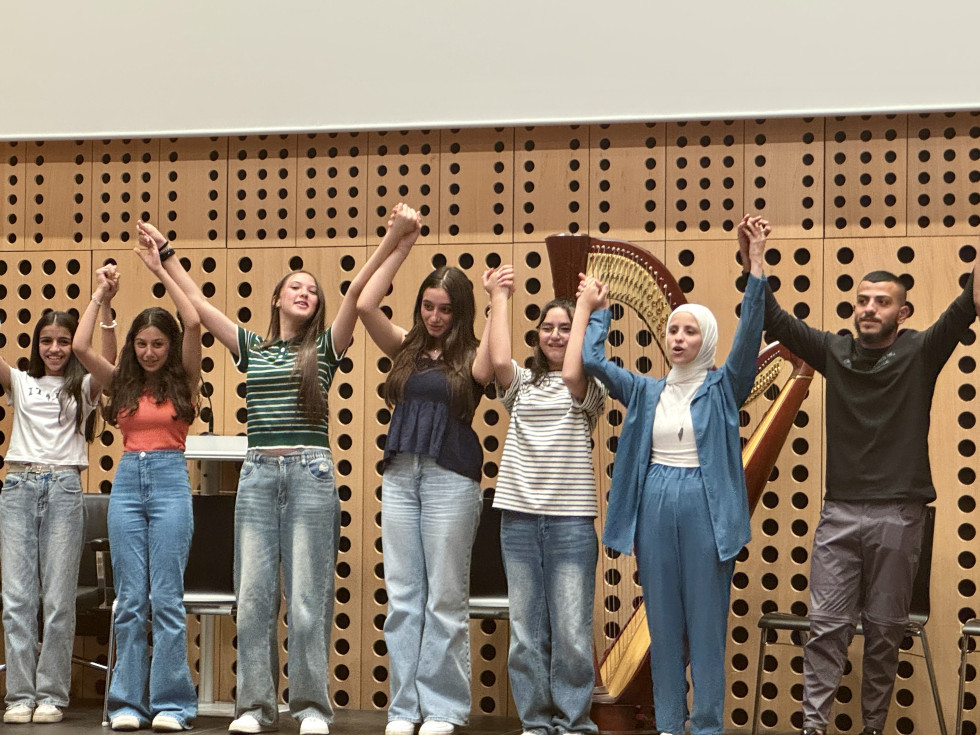Slovenia stands with young people for peace: music as a language of peace

Artists from 19 countries, all united by a love of music, creativity and a desire for peace | Author MZEZ
The SIT DOWN – Peace Child honours the 80th anniversary of the founding of the United Nations and the end of World War II. During a ten-day music camp, young people will create a musical called Peace Child, a story about cooperation, dialogue and shared visions for the future. What makes this project unique is that young people themselves co-create the lyrics and music by discussing key global challenges, such as peace education, climate change, safe migration and the use of artificial intelligence, as well as topics of love, acceptance and solidarity.
The Slovenian highlight of the project will be the premiere of Peace Child at the Križanke Outdoor Theatre on 23 August as part of the Ljubljana Festival. The first international presentation will then take place at the Vienna Konzerthaus on 23 October, on the eve of United Nations Day. SPIRIT Slovenia and its partners are organising business forums to accompany the concerts, bringing together art, diplomacy and business under the shared vision of sustainable development.
Art and advocacy go hand in hand
In addition to the music camp, from 14 to 16 August, the young participants took part in advocacy workshops. During the three-day programme, 24 children and young people explored ways in which they can contribute to shaping a more just, secure and sustainable future. They learnt how the United Nations works, discussed the UN Declaration on Future Generations and identified five themes that are particularly important to their generation: peace and security, safe migration, a sustainable environment, inclusive societies and intergenerational justice.
The participants received negotiation training, discussed the challenges of the digital age in the light of the documentary The Social Dilemma, and designed their own advocacy campaigns for global issues. The three-day programme concluded with a World Café event involving open discussions. During these discussions, young people sought common solutions and realised that cooperation, solidarity and dialogue are essential for building a better future.
Amwaj – Waves of hope from Palestine
One of the most emotional stories of the project is the participation of Amwaj, the Palestinian youth choir whose name means 'waves'. The Amwaj Choir was founded ten years ago in Bethlehem and Hebron by Italian musician Michele Cantoni and his wife Mathilde Vittu, a professor at the Paris Conservatoire. Cantoni, who has lived in Palestine for twenty years, says that “Music is one of the most powerful ways to express dignity and resistance, which is why it remains ever present among children, even when violence and restrictions escalate on a daily basis.”
During its first decade, the Amwaj Choir evolved into much more than just a choir. It became a symbol of artistic resistance, hope and dignity. The project brings together around 70 children and young people from communities divided by walls and checkpoints. Some of them walk several kilometres to attend rehearsals even when the roads are closed. Despite these circumstances, Amwaj provides a high-quality music education and facilitates international exchanges. Furthermore, it is nurturing a new generation of young conductors and teachers. The performances blend different languages and traditions, and many of the pieces have been written especially for the choir and premiered at its concerts. When the choir takes to the stage, they sing about the realities of occupation and uncertainty, but also about solidarity and hope.
The participants – the Palestinian and SUPERAR BIH choirs, whose members have experienced war and displacement, the Ukrainian musicians who have continued their musical education in Slovenia thanks to the Slovenian Youth Orchestra under the artistic direction of Živa Ploj Pršuh, and young artists from the United Kingdom, Turkey, Italy, Japan, Hungary, Pakistan, Montenegro, Serbia, Croatia, Spain, the United States, Russia, France, Romania and Wales, together carry a valuable message to the world. This is more than a simple cultural event. It is an example of cultural and scientific diplomacy that transcends political and geographical boundaries to build bridges between people and open up spaces for dialogue. It is an act of humanity and solidarity that gives young people the opportunity to convey the most powerful message of our time through music. ‘Peace is possible if we work together to create it.’

